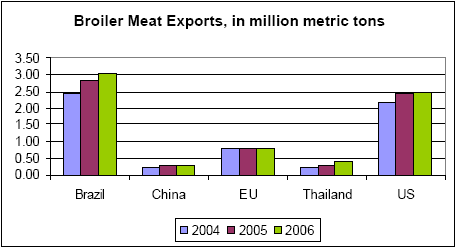



International Egg and Poultry Review: Brazil and Korea
By the USDA's Agricultural Marketing Service - This is a weekly report looking at international developments concerning the poultry industry, this week looking at Brazil and Korea.
Brazil Poultry Exports
Brazil became the largest world exporter of chicken in 2004. January
through December 2004 chicken exports reached 2.47 million metric
tons, up 26 percent from 2003 (1.96 mmt). In 2005 exports are estimated
at 2.84 mmt and in 2006 exports are forecast to reach 3.04 mmt. Brazil
exports poultry to about 135 countries.

The Ministry of Agriculture is working to create a “Regionalization of Sanitary Controls for Poultry”. The object is to create a protocol between six states from the center-south regions of Brazil. These states would restrict the transit of birds, eggs and other poultry related products and by-products for interstate commerce. The southern states of Rio Grande do Sul, Parana and Santa Catarina are major poultry producing states.

Broiler meat production is estimated to be 8 percent higher in 2005
and by 5 percent in 2006. Turkey meat production estimates are up 17
percent for 2005 and 11 percent for 2006.
On September 12, 2005 the WTO Appellate Body told the EU to reduce
trade barriers on boneless chicken imports from Brazil and Thailand.
The panel said the EU broke international rules when it changed the
classification of salted chicken cuts from 0210 to 0207, which led to
an increase in the tariffs levied on them.
The WTO had already decided in Brazil’s favor in February 2005, but
the EU appealed that decision in June.
Brazil and Thailand had been exporting “salted” poultry to the EU since
1997 under the HS code 0210 "meat and edible meat offal, salted, in
brine, dried or smoked," until the EU reclassified those items in 2002.
Poultry exports under the HS heading 0210 had increased to over 200
thousand metric tons per year, or about one half of total poultry imports.
HS code 0207 covers "meat and edible offal, fresh, chilled or frozen."
The final report will have to be adopted by the Dispute Settlement
Body in the WTO within 30 days. The EU will have up to 30 days to
announce its formal position.
Source: USDA /Foreign Agricultural Service, USDA/Economic Research
Service, news wires
Korea: Poultry and Poultry Products
As of April 14, 2005, Korea removed an import ban placed on U.S.
chilled and frozen poultry products. The ban was implemented on
February 24, 2004 after confirmation of highly pathogenic avian influenza
in Texas. The low availability of imported chicken products and
record high farm gate prices for broilers led to an increase of broiler
chick placements. Poultry production estimates are 432,000 metric
tons (MT) for 2004, 450,000 MT for 2005 and are forecast at 459,000
MT for 2006.
Imports are forecast to increase by 27 % to 70,000 MT in 2006. Some
traders have complained the quality of U.S. products is not as good as
it was before the outbreak of HPAI, including increased losses during
thawing and quality of U.S. thigh products which don’t meet Korean
demand.
Denmark, UK, Taiwan, France, Australia, Brazil, Japan, Hungary, and
US are the approved suppliers for fresh, chilled or frozen poultry meat
and for heat-treated poultry meat. China and Thailand are only approved
for heat-treated poultry meat. On April 2, 2005, Korea approved
four Brazilian poultry plants to export to Korea and, according to
sources, the first trial shipment, of chicken wings and boneless meat,
arrived in August 2005.
Between January 2005 and August 20, 2005 Korea imported 15,582
MT of legs from the U.S. and 11,206 MT from Denmark. Wing imports
totaled 70 MT from the U.S. and 5,612 MT from Denmark.
Source: USDA/Foreign Agricultural Service
To view the full report, including tables please click here
Source: USDA's Agricultural Marketing Service - 20th September 2005








